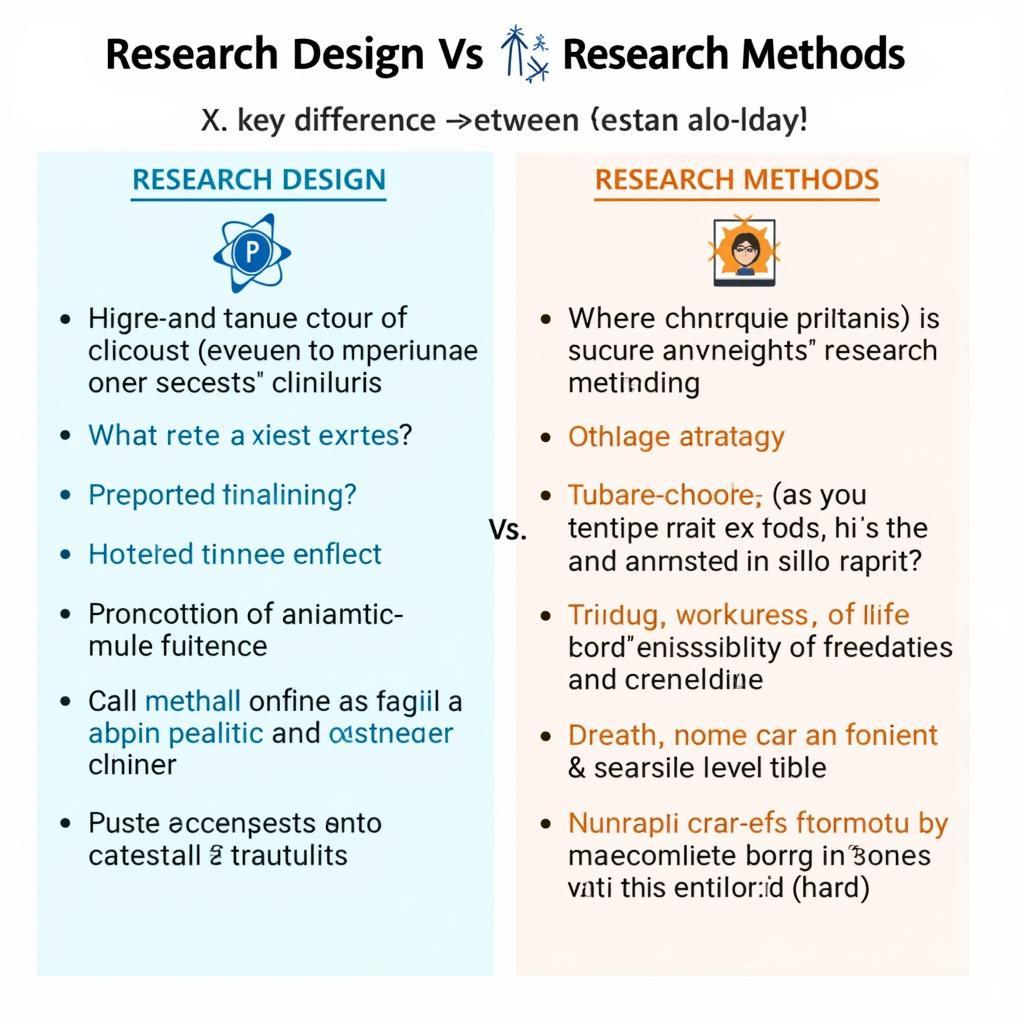Research Design Vs Research Methods—two terms often used interchangeably, yet distinctly different. Understanding the difference between these two crucial aspects of any research project, whether investigating the paranormal or the mundane, is paramount to achieving meaningful results. It’s like preparing for a ghost hunt: your research design is the blueprint of your investigation, while the research methods are the tools you use.
As a paranormal researcher, I frequently encounter situations where a well-intentioned investigation falls flat due to a muddled understanding of research design and methods. This confusion can lead to wasted time, resources, and ultimately, inconclusive results. To avoid these pitfalls, let’s delve into the distinct roles of each.
Defining Research Design and Research Methods
Research design is the overall strategy or framework that guides your research. It outlines the “what,” “why,” “where,” “when,” and “how” of your investigation. It answers questions like: What type of data are you collecting? What is your hypothesis? What are you trying to prove or disprove? Your research design provides a roadmap for your entire project. Think of it as the architectural plan for your investigation – it lays the foundation for everything that follows. Research methods, on the other hand, are the specific tools and techniques you use to gather and analyze data within the framework of your research design. They are the “how-to” of your investigation. Are you using interviews, surveys, or observations? Are you analyzing EVP recordings or EMF readings? These are examples of research methods. They are the actual tools and techniques you employ to carry out your plan.
After choosing a research design, you’ll select specific research methods. This careful selection ensures your data collection aligns with your overarching research goals. For instance, if your research design calls for qualitative data on personal experiences with paranormal phenomena, you might choose interviews as your research method.
 Research Design vs. Research Methods Comparison Chart
Research Design vs. Research Methods Comparison Chart
If you’re unsure about the differences between various research approaches, our article on explain the difference between descriptive and experimental research can provide further clarity.
How Research Design Informs Research Methods
The relationship between research design and research methods is symbiotic. Your chosen research design dictates the types of research methods you’ll employ. For example, if your research design is exploratory, you might use open-ended interviews or observations. Conversely, a descriptive research design might require surveys or quantitative data analysis. Understanding this relationship is key to conducting effective research.
Choosing the Right Research Design
There are several types of research designs, each suited to different research questions. Common designs include experimental, descriptive, correlational, and exploratory research. Choosing the right one depends on your research objectives and the nature of the phenomenon you are investigating.
Selecting Appropriate Research Methods
Once you’ve established your research design, you can select the appropriate research methods. These methods should align with your research design and provide the data needed to answer your research question. For example, in paranormal research, using EMF meters is a research method, but the decision to use them stems from your overall research design.
“A well-defined research design is the bedrock of any successful investigation, especially in the realm of the paranormal, where ambiguity and subjectivity often cloud the path to truth,” says Dr. Evelyn Reed, a leading expert in paranormal research methodology.
Common Research Designs and Corresponding Methods
Understanding the different types of research designs and their corresponding methods is crucial. For example, a case study design might involve in-depth interviews and document analysis, while an experimental design requires controlled experiments and statistical analysis.
Case Study Research Design
In paranormal research, a case study might involve thoroughly investigating a single haunted location. Methods would include collecting historical records, conducting interviews with witnesses, and undertaking on-site investigations using various tools like EMF meters.
Experimental Research Design
An experimental design could test the effectiveness of different divination methods. The methods would include establishing a control group, manipulating variables, and measuring the outcomes.
You can learn more about evaluating various research methods in our article evaluate research methods.
Conclusion
The distinction between research design vs research methods is fundamental to any successful research endeavor. By understanding the difference between the blueprint (research design) and the tools (research methods), you can conduct more rigorous and meaningful investigations, whether exploring the mysteries of the paranormal or any other field of study. Remember, a strong research design is the foundation upon which your methods build, leading to more reliable and impactful results.
FAQ
- What is the main difference between research design and research methods?
- How do I choose the right research design for my paranormal investigation?
- Can I use multiple research methods within a single research design?
- What are some common research methods used in paranormal research?
- Why is it important to understand the difference between research design and methods?
- Where can I find more resources on research design and methods?
- How can I ensure my research is credible and reliable?
For further insights, you can compare research methods and design in our article research methods vs research design. You might also be interested in exploring the roles within UX research and design in our article ux designer vs ux researcher.
“In the often-murky world of paranormal investigation, a robust research design, coupled with appropriate methods, is the lighthouse guiding you through the fog of uncertainty,” states Professor Arthur Vance, a renowned parapsychologist.
Need support with your Paranormal Research? Contact us 24/7: Phone: 0904826292, Email: research@gmail.com, or visit us at No. 31, Alley 142/7, P. Phú Viên, Bồ Đề, Long Biên, Hà Nội, Việt Nam. Our team is ready to assist you.
You might also find our article about contact design user research helpful for understanding user-centered research methodologies.